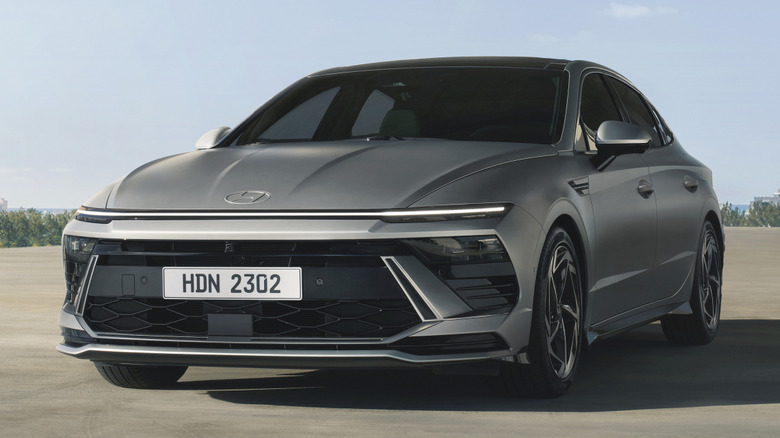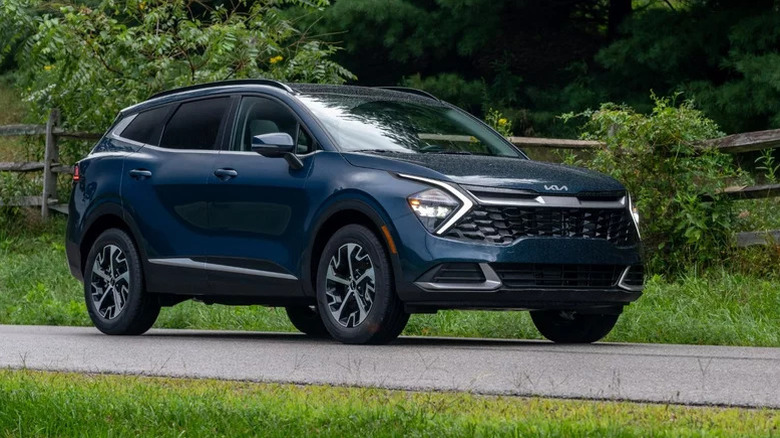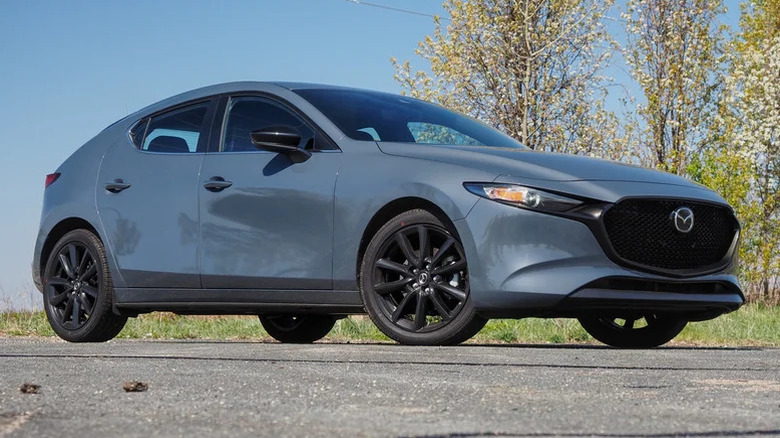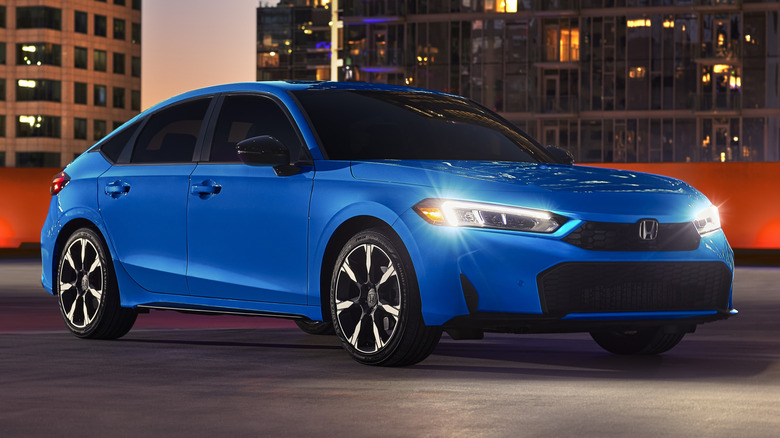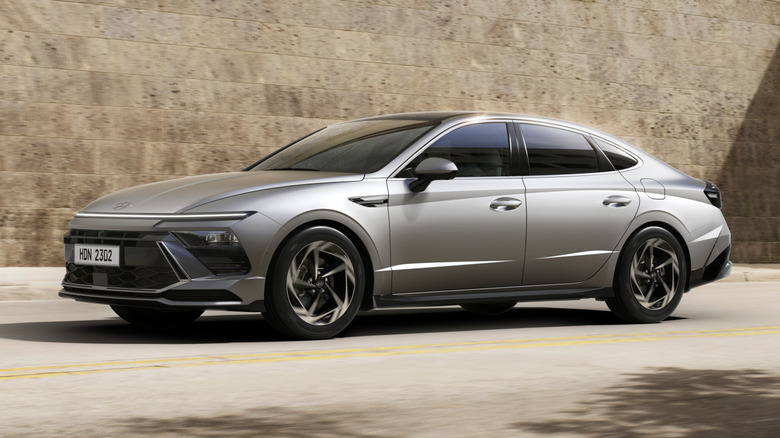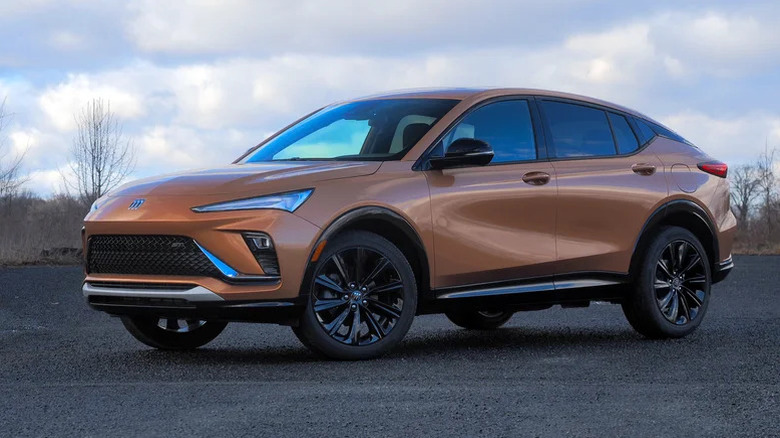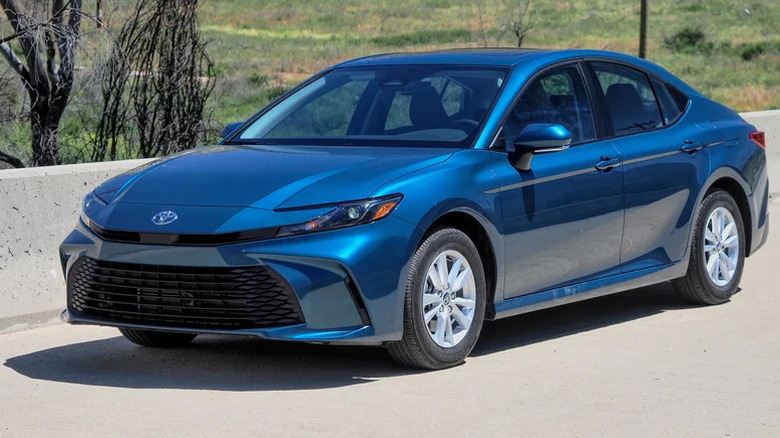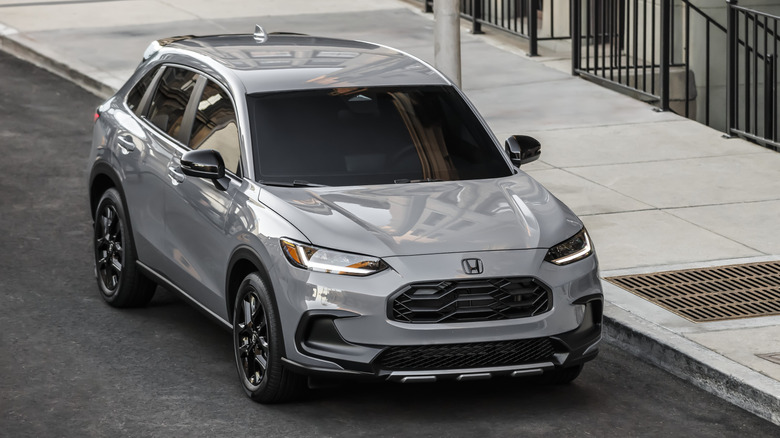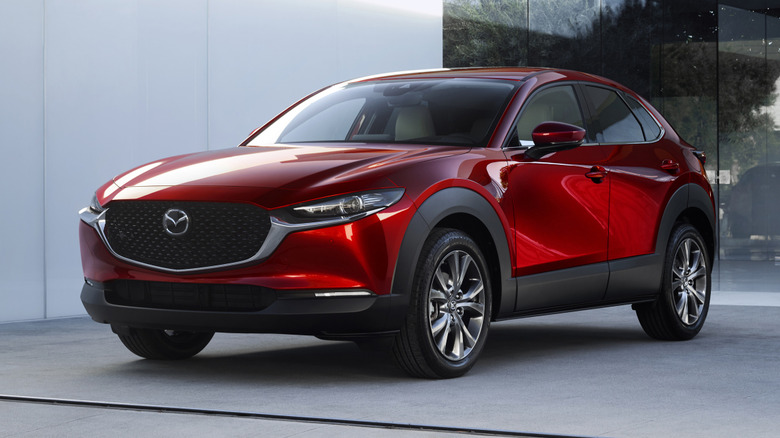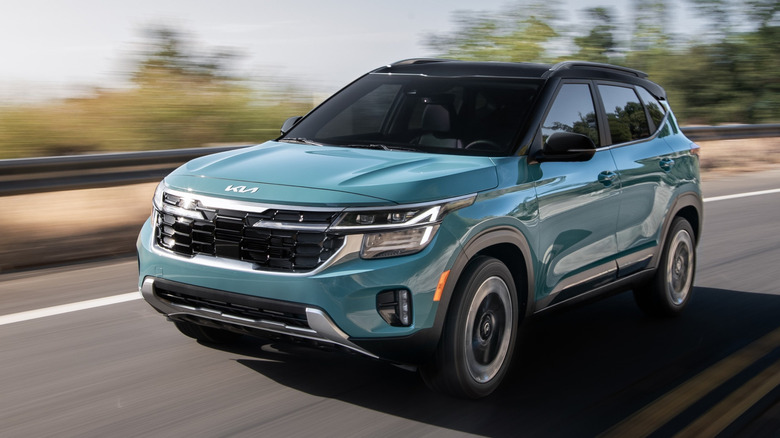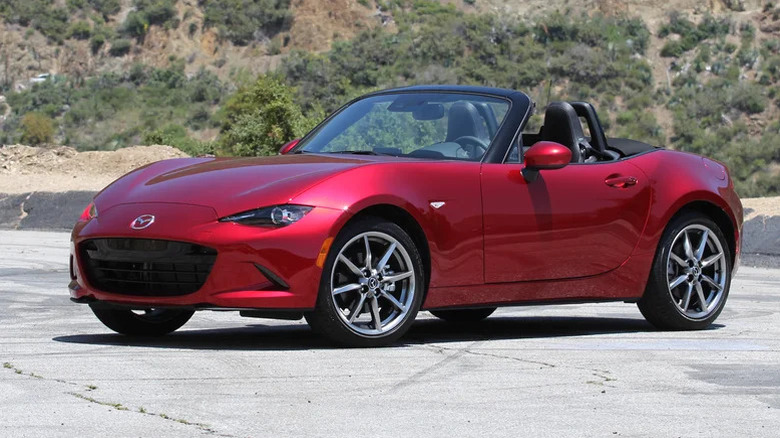10 Of The Nicest Base Model Cars Under $30,000
According to KBB, the average new car price in December 2024 was $49,740 — that's a few hundred dollars shy of the all-time record, which was set in December 2022. Many buyers are resorting to increasingly long loan periods in order to afford their new cars, even if that means paying more interest overall. It's not uncommon to see eight-year loans offered at dealers.
However, buying a new car doesn't have to be financially ruinous. Although there are fewer truly cheap cars than there once were, there are still plenty of attractively priced models out there with more features than you might expect. The days of the "econobox" are arguably over, and the best affordable base-spec cars now offer interior tech and exterior styling that looks more premium than their prices might suggest. We think that these 10 models are among the nicest cars available under $30,000, with each one offering an all-round appealing package that is competitive with pricier cars.
Kia Sportage – $27,390
The Kia Sportage last received a significant overhaul for the 2023 model year — the model's cabin received a makeover and its standard tech stack was updated to compete with an ever-changing field of rivals. The Sportage has historically built its reputation on offering good value, and the latest iteration is no different, with base trims starting at $27,390 (plus a $1,395 destination fee) for 2025. Even the cheapest trims get infotainment staples like Apple CarPlay and Android Auto as standard, with the infotainment system being controllable via a touchscreen and plenty of physical buttons. Drivers put off by the modern tendency for cars to rely too much on touchscreens won't have to worry here.
The Sportage's interior upholstery also remains among the nicest at its price point, although buyers will have to venture above the $30,000 mark if they want the nicest materials that the Sportage range has to offer. The cabin is roomy enough to fit a small family, and in our review of the Sportage Hybrid, we found there's still plenty of cargo space on offer, too. Efficiency varies significantly between powertrains, and the base gas powertrain can't match the frugality of the pricier hybrid. However, both remain competitive within their segments, achieving up to 28 mpg and 43 mpg respectively, per the EPA. As a bonus, the Sportage is also one of the cheapest cars on the market to insure, which will help drivers keep their costs to a minimum.
Mazda Mazda3 Hatchback – $24,950
Finding a car capable of delivering driving fun on a budget isn't easy, particularly with the popularity of crossovers. Taller, larger vehicles don't naturally lend themselves to an enjoyable driving experience, but buyers looking for a practical-but-fun car aren't entirely out of luck. In our review of the Mazda3 Hatchback, it proved that cheap, engaging cars aren't dead yet. And its handling isn't the only reason to consider buying it.
The car starts at $24,950 for the 2025 model year, plus a mandatory $1,185 destination fee. That pushes the total price excluding state fees and dealership fees up to just over $26,000, considerably less than our $30,000 benchmark. However, move up the trim range and it's easy to add a significant premium to that final amount, with the top-spec 2.5 Turbo Premium Plus starting at $36,950 excluding fees.
Even base-spec models are well equipped for their price bracket, with standard features including an 8.8-inch infotainment screen, a voice command function, and Apple CarPlay and Android Auto connectivity. Mazda also includes a suite of assistive driving features as standard, including a lane departure warning, lane keep assist, and a blind spot monitor.
Honda Civic – $24,250
The Civic nameplate is one of the long running names on the market, having been in constant production since 1972. The current Civic is no less appealing than its predecessors, both in sedan and in hatchback form. The former is slightly cheaper, starting from $24,250 excluding fees, while the latter starts from $27,450. Both are subject to a $1,150 destination fee, which means both can be had for under $30,000.
Base-spec models get a 2.0-liter four-cylinder gas engine, but both the sedan and hatchback are also available with pricier hybrid options for 2025. The hybrid Civic is one of the most fuel efficient cars on the market, achieving a combined 49 mpg. Non-hybrid models achieve a still-impressive combined 36 mpg.
The base-spec Civic receives Honda's competitive suite of safety features as standard, including lane departure warning, adaptive cruise control, and traffic jam assist. Its cabin isn't the most upmarket for the money, but our reviewer noted that the updated 2025 model's interior upholstery and switchgear still felt high quality. The updated tech stack is also an improvement over the outgoing model, although the base Civic trim misses out on some of the added niceties.
Hyundai Sonata – $26,800
Much like its sister brand Kia, Hyundai has carved out market share for itself by consistently providing a lot of car for minimal upfront cost. That remains true with the Sonata sedan, which starts from $26,800 (excluding a $1,195 destination fee). As standard, buyers get a 12.3-inch infotainment touchscreen with Apple CarPlay and Android Auto capabilities, two rear USB charging ports, and adaptive cruise control. Six-way adjustable front seats are upholstered in cloth in base-spec cars, with only the top-spec Limited trim getting leather seats.
All trims get a 2.5-liter four-cylinder engine, although higher trims get a turbocharged version making 290 hp. Base trims offer 191 hp. All-wheel drive is available on certain Sonata trims, but not on the base model. Sedans might not be the all-conquering body style that they once were, but there are still plenty of affordable sedan models out there for buyers to choose from. Alongside the Sonata and the aforementioned Civic, Toyota also offers multiple sedans under $30,000, including the Corolla and the larger Camry.
Buick Envista – $23,700
Part of the reason for the declining popularity of sedans is the rising popularity of crossovers. The Buick Envista is one of newer names in the affordable crossover segment, and it's a little different from what many buyers will expect from a Buick. For starters, it looks sharper and sportier than older Buick models, although with a 1.2-liter three-cylinder engine under the hood, its performance can't match up to its looks. Still, in our review of the Envista, we found it sprightly enough for urban and suburban commutes, and its interior was a pleasant place to spend time.
Reviewer Chris Davies did have a few gripes, particularly with the bare-looking infotainment system and lack of available all-wheel drive, but nothing was close to being a dealbreaker. Unless you need the all-weather reassurance of being able to send power to all four wheels, the generous equipment list and distinctive styling of the Envista is enough to make it well worth considering, especially given its low starting price of $23,700 plus a $1,095 destination fee. Even the top-spec Avenir trim, with its upscale leather-trimmed seats and extra driver assistance features, is available for just under $30,000 including destination fees.
Toyota Camry – $28,700
Much like the Honda Civic, the Toyota Camry is a perennial strong seller, and for good reason. A starting price of $28,700 coupled with a destination fee of $1,095 makes it one of the most expensive cars here, and only just under the $30,000 mark. However, in our first drive of the 2025 model, we felt the added space it offered compared to the smaller Corolla sedan could make it better suited to family hauling duties. Toyota's reputation for building safe cars is a hard earned one, and the 2025 Camry comes with the automaker's Safety Sense 3.0 suite of driver assistance features as standard.
Also standard is an 8.0-inch infotainment touchscreen with wireless Apple CarPlay and Android Auto, plus available SiriusXM. A six-speaker audio system is standard on base trims, and buyers who want the optional nine-speaker JBL system will have to step up within the trim range and cross over the $30,000 mark in the process. The Camry's 2.5-liter four-cylinder engine should be familiar to anyone with experience of driving a recent Toyota, and in base form, the car is only available with front-wheel drive.
Honda HR-V – $25,400
Slotting below the CR-V in Honda's lineup, the HR-V is a smaller, cheaper crossover that still delivers much of the same appeal as its larger sibling. It shares a platform with the Civic and its interior is also similar, with plenty of shared switchgear. Much like the Civic, Honda has chosen to retain physical buttons for many of the car's controls, which reduces the driver's reliance on the touchscreen.
The HR-V starts from $25,400 for the 2025 model year, excluding a $1,395 compulsory destination fee. Upgrading to the mid-spec Sport trim will cost at least $27,500 excluding fees, while the top-spec EX-L costs at least $29,500 excluding fees. Which one to pick is a matter of personal preference — in our review of the 2023 model, SlashGear's own Cameron Aubernon appreciated the larger 9.0-inch touchscreen in our test car, but the standard 7.0-inch unit will do just fine for most people. All trims include Apple CarPlay and Android Auto connectivity as standard.
Mazda CX-30 – $24,995
Essentially the crossover counterpart to the Mazda3, the CX-30 shares many similarities with the long-running hatchback. Both cars are among the most fun to drive in their respective segments, both come with interiors that feel more premium than their asking price would suggest, and both can be bought for under $30,000. For 2025, the CX-30 starts from $24,995, excluding a $1,420 destination fee.
The CX-30's infotainment is competitive with what else is on offer at its price point, although it's not the very best in class. Wired Apple CarPlay and Android Auto is available, but base trims have to forgo a wireless option. In contrast, similarly priced crossovers from Kia, Hyundai, and Buick all get wireless connectivity as standard. However, in our review of the 2024 CX-30, we found it offers a much nicer driving experience than any of those other cars, and that alone makes it worthy of inclusion here.
Kia Seltos – $24,690
It might be small, but the Kia Seltos offers a lot given its compact package. For starters, ranks very highly among small cars with lots of trunk space, with 26.6 cubic feet of space on offer behind the rear seats. Secondly, it's available at a highly competitive price, with base models starting from $24,690 (plus a $1,395 destination fee) for 2025.
Like most Kia models, the Seltos also boasts a generous list of standard equipment, including an 8.0-inch infotainment touchscreen, wired Apple CarPlay and Android Auto, and various driver assistance features. However, after spending time reviewing the Seltos, we weren't convinced that it was quite as aesthetically pleasing inside as other models in Kia's range. Also notable was the underwhelming base engine, which offers a modest 146 hp. It's not without its flaws then, but for maximum hauling capacity, solid build quality, and a generously sized passenger cabin, there's plenty to like.
Mazda MX-5 Miata – $29,330
Unlike all the other cars here, you can't quite get a Miata for under $30,000 once destination fees are taken into account. It officially starts from $29,330, but a $1,185 destination fee pushes it a few hundred dollars over $30,000. Still, since its MSRP is still under budget — and it's unlike anything else at its price point — we're including it here. Mazda's hatchbacks and crossovers do an admirable job of balancing driving fun and practicality, but none of them come close to matching the enjoyment of the MX-5 Miata.
The Miata formula has remained unchanged over the decades, and in our review of the 2023 MX-5, we found its focus still firmly on keeping weight to a minimum and ensuring the driver has maximum feedback from the wheels. The result is plenty of driving fun without the need to hit speeds that could get you in trouble with law enforcement. Few other cars remain as purely focused on driving in today's market, with only the Toyota GR86/Subaru BRZ coming close. However, while the GR86 is the cheaper of the "Toyobaru" twins, it retails for $30,000 excluding destination fee, making the Miata cheaper by the tiniest of margins.
